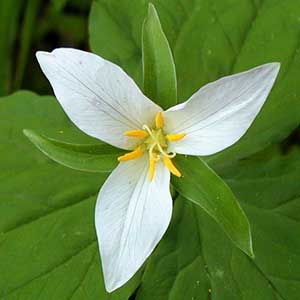Trillium ovatum
Trillium maculatum
Pacific trillium, trillium, western trillium, western wake-robin, western white trillium, white or western trillium, white trillium
spotted trillium, spotted wakerobin
semierect to horizontal, short, stout, praemorse.
horizontal, brownish, short, thick, praemorse, not brittle.
1–2, round, 2–5 dm, ± slender, glabrous.
1–3, round in cross section, 1.4–4 dm, slender to stout, glabrous.
sessile, subsessile, or short-petiolate;
blade medium green, sometimes blotched and mottled, main veins prominent, ovate-rhombic, 7–12 × 5–20 cm, continuing to expand during anthesis, base rounded, apex acuminate.
held well above ground, tips only touching ground in early anthesis, sessile;
blade dark green, mottling darker, mottled to varying degrees, mottling becoming obscure with age, broadly ovate-elliptic to elliptic, 7–15 × 4.6–6.7 cm, not glossy, apex rounded or barely acuminate.
erect or nodding, odorless;
sepals spreading to horizontal, green, lanceolate to oblong-lanceolate, 15–50 × 6–20 mm, margins entire, apex acute;
petals erect-ascending, usually wide-spreading from base, exposing entire pistil, white or with pink or blush markings, lacking V-shaped markings, fading to rosy pink, purple, or dark red, veins not deeply engraved, ± linear to widely obovate, 1.5–7 ×1–4 cm, widest at or above middle, thin-textured, margins flat to undulate, apex acuminate;
stamens prominent, slightly recurved-spreading to straight, 10–18 mm;
filaments white, shorter than anthers, slender;
anthers yellow, 4–16 mm, slender, dehiscence latrorse-introrse;
ovary green or white, ovoid, 6-angled, 5–12 mm, attachment ± 3/4 ovary width;
stigmas recurved, barely connate basally, greenish white or white, linear, not lobed adaxially, 6–10 mm, uniformly thin;
pedicel erect to leaning, 2–6 cm.
erect, odor faintly spicy and bananalike;
sepals displayed above bracts, spreading almost to horizontal, often suffused or streaked with purple-maroon, lanceolate-linear, 22–50 × 5–7 mm, margins entire, apex rounded-acute, recurving slightly;
petals long-lasting, spreading-erect, ± connivent, ± concealing stamens and ovary or sometimes slightly spreading early, only partially obscuring stamens, becoming more erect and even touching in the manner of Trillium cuneatum when older, clear dark red-maroon, or reddish purple, without muddy or brown tones of many purple sessile species, or, rarely, purple basally and yellow toward apex, or clear sulfur yellow, not spirally twisted, narrowly oblanceolate-spatulate to linear-spatulate, widest above middle, narrowing to apex, 4–7 × 0.7–1.7 cm, thick-textured, margins entire, slightly involute in proximal 1/2, apex acute to round-acute;
stamens erect, 12–20 mm;
filaments dark purple, 2–3 mm, widest at base, much shorter than anther sacs;
anthers erect, straight, brownish purple, 10–16 mm, dehiscence introrse on broad connective;
connectives brown-purple, straight, essentially not extended beyond anther sacs;
ovary dark purple, ovoid, weakly 3-angled to smooth (rarely very obscurely 6-angled), angles often obscured in large, turgid ovary, 8–11 mm;
stigmas erect, divergent-recurved, distinct, purplish, subulate, 2–4 mm, fleshy.
baccate, green or white, ± odorless, broadly ovoid, obscurely winged, 1.2–2.8 × 0.7–1.9 cm, pulpy-moist.
dark purplish green, odor not reported, ovoid, obscurely 3- to 6-angled, bearing persistent stigma, 1 × 2 cm, pulpy.
= 10.
Trillium ovatum
Trillium maculatum
Varieties 2 (2 in the flora).
(Discussion copyrighted by Flora of North America; reprinted with permission.)
In their account of the Carolinas flora, A. E. Radford et al. (1968) did not treat Trillium maculatum or give any explanation of why they omitted this species, which is fairly widely distributed in southeastern South Carolina and morphologically is one of the more distinct sessile trilliums.
Many color forms occur and have been named. In forma luteum J. D. Freeman, for example, all floral organs lack purple pigment, and the petals are clear, soft yellow, whereas forma simulans J. D. Freeman has yellow petals with purple bases, and purple stamens and carpels. These are illustrated in color in F. W. Case and R. B. Case (1997).
(Discussion copyrighted by Flora of North America; reprinted with permission.)
1. Bracts sessile; petals lanceolate to obovate, 1.5–7 × 1–4 cm | var. ovatum |
1. Bracts distinctly short-petiolate; petals linear to linear-lanceolate, 0.5–2.4 × 0.2–0.6 cm | var. oettingeri |
- Local floras:
BC,
CA,
OR,
WA
- Local Web sites:
CalFlora,
CalPhotos,
Flora NW,
PNW Herbaria,
Turner Photog.
WildflowerSearch
iNaturalist (observations)
USDA Plants Database
- LBJ Wildflower Center
- SEINet
- Plants of the World Online
- Encyclopedia of Life
- Wikipedia
- Google Image Search


